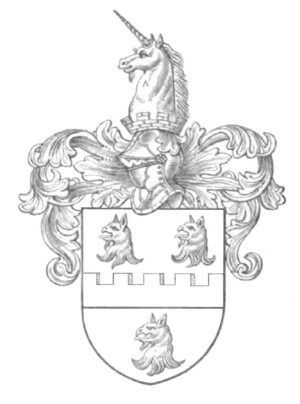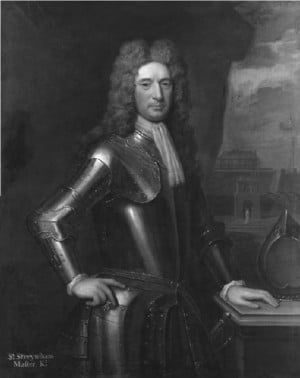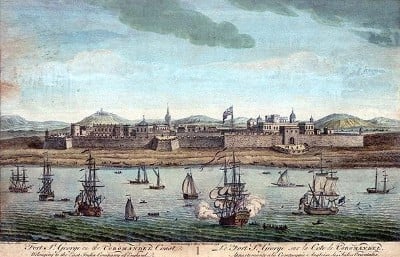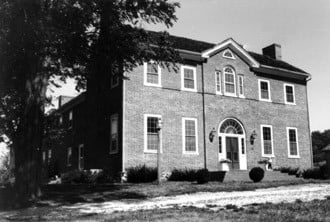The Master Family
(Lords of the Manor of Codnor 1692 - 1850)
This page covers the history of five generations of the Master family, who were lords of the Manor of Codnor from 1692 to 1850
In 1692 the castle and estate of Codnor, together with its members; Heanor, Loscoe, and Langley, and the manor of Codnor Park were purchased by Sir Streynsham Master.
1st Generation
Sir Streynsham Master was a descendent of a family that most probably originated from Flanders and later settled in kent sometime after 1200 AD.
The Master family grew in stature over the years and by 1608 James Master of East Langdon was granted a full Coat of Arms by William Camden
( Clarenceux King-of-Armes.)

Master family Coat of arms
The Master Coat of arms can be split into the following elements.
Crest: A unicorns head, Argent (White), issuing out of a mural crown, Or (gold).
Arms: (Being the shield) Azure (blue), a fesse embattled (this refers to the castleated band) between three Griffins heads.
Motto: Non minor est virtus quam quserore, parta tueri.
Meaning: it is no less an achievement to keep possession than to acquire it.
Streynsham was born in Langdon on the 28th October 1640. His father was Richard Master who later became the deputy-lieutenant of Dover castle, and his mother was Anne Oxenden, daughter of Sir James Oxenden of Dene.
In total they had twenty children of which Streynsham was the eighth son and thirteenth child.
He received a good education at Canterbury grammar school and by the age of 16 was ready to leave his family and travel to India with his uncle, Sir George Oxenden.
Sir George was president of the East India Company’s factory in Suratt and he believed this would be the ideal place for Streysham to start his career.

Sir Streynsham Master, portrait by Charles D'Agar 1710-1720
The East India Company established commercial settlements in India with the intention of controlling the trade of such items as Cotton, Silk, Tea, spices and saltpetre to England. It eventually grew so powerful that it virtually ruled all of India.
Streynsham joined the East India Company in 1659 and soon proved to be a great asset to the company.
During the latter part of the1600’s Sevagee, an enemy of the Mogul sovereign of India and founder of the Mahratta Empire, repeatedly attacked East India Company assets.
In 1670 Sevagee’s army attacked the factory at Surat, with the intention of killing and plundering all within
But Streynsham successfully defended the factory with just a small Garrison of thirty men. His bravery was rewarded with a gold medal and the grateful acknowledgement of the company.
At the age of Thirty-two he returned to England and purchased the estate of Wallett’s court near Dover. Just two years later on the 17th May 1674 he married Diana Bendish, daughter of Sir Thomas Bendish of Ramstead Essex.
But his happiness was short lived, his wife died on November 20th the same year.
In 1675 he was appointed to the Governorship of Madras, with nothing now to keep him in England he set sail for India.
By this time the East India Company had immense power and controlled most of the trade passing through India, but it wasn’t without its problems.
As well as the attacks from Sevagee’s army, the French were also keen to re-establish trade routes in India. Then there was the constant threat of piracy when the ships left the safety of the harbour.
There was also the problem of private trade by officials on the company payroll.
The Company understood that any agent that was required to work under such dangerous conditions would require an incentive to stay loyal. So high-ranking officials in the company were allowed some degree of private trade, but it must be kept above board and they must always put the interests of the company first when negotiating any trade deals.
But this was impossible for directors back in London to police. The company was loosing thousands of pounds to private trade deals set up by high-ranking employees in India.
They needed someone who they could trust, an individual who could takeover the roll of Governor of Madras and reform the outdated administrative procedures and also bring law and order to this huge trading empire.
Streynsham was the ideal candidate for this roll, he assumed his position of Governor of Madras in January 1677 at Fort St. George in Madras; this was the countries administrative centre for the entire East India Company.

Fort St George, Madras, on the Coromandel Coast, 1754;
painting by Jan Van Ryne
He quickly made changes designed to improve the day-to-day life of people living and working in these huge settlements.
He introduced the roll of scavenger, who was responsible for removing dirt and waste from the streets but also empowered to collect taxes, Watchmen were appointed to stand guard at night and Taverns, Hotels and theatres had to be licensed.
He also appointed choulty judges to administer justice.
He didn’t forget the employee’s religious needs. On ladies day 1678 he began work on St Mary’s church, which was finished in 1680 and was the first Anglican Church to be built in India.

St Mary's Church, Fort St George. Drawn and engraved by
J.W. Gantz, Vepery, 1841.
He also introduced new methods of book keeping designed to record all transactions whether they were official company business or private individual deals.
The accounts would be accessible to all members of staff including certain subordinates. The idea being that it would be very difficult for any corrupt individual to setup private trade deals without the knowledge of other company officials both within the settlements and back in London.
This new regime made Streynsham very unpopular with certain greedy members of the company. They could no longer hide their private money making deals.
Streynsham retained his position of Governor of Madras for four years, in which time he greatly improved the company’s efficiency and profile.
However in 1681 complaints of his own private trade deals in diamonds were reported to accountants in London by jealous company officials.
He was forced to return to England to defend his reputation against these accusations.
With the help of his meticulous book keeping he soon proved that all his trade deals were above board and he was totally vindicated of any wrong doing.
To rub salt into his accusers wounds, he was soon after elected as a Director of the Company.
By the 25th September 1690 he had married his second wife, Elizabeth Legh, daughter of Richard Legh of Lyme in Cheshire.
It was soon after this in 1692 that Sir Streynsham Master purchased Codnor Castle and its neighbouring estates from Sir Richard Neile and his Son Paul. His wife Elizabeth had already expressed a desire to live near her family in the North, but by this time Codnor castle had been partially dismantled and it is unlikely that any of it was habitable.
Streynsham managed to obtained a private Act of Parliament, which enabled him to exchange his lands in Kent (assigned under his marriage settlement) with lands in Derbyshire, he sold Wallets Court and purchased Stanley Grange near West Hallam as their new home.
In 1697/8 Streynsham being chairman of the court, was knighted by King William III of Orange, becoming Sir Streynsham Master.
He was by now a wealthy landowner but had little time to relax at Stanley Grange as he also owned properties in the Strand St. Clements Danes, Middlesex.
Records show that in 1698 he leased Codnor Castle together with Castle farm and 185 acres of land to Edmund Winter of Langley, Heanor.
The draft lease was for 16 years at £76 per year. However after only eight years Edmund Winter absconded.
A new lease was agreed between Sir Streynsham Master and Christopher Colclough, junior for,Castle Farm and Old Farm in Codnor Park. In 1707 it is noted that he was feoffee (trustee) of St.Thomas’s Hospital in Sandwich, and by 1711 he had assumed the position of High Sheriff of Derbyshire.
He also became trustee for St. Georges chapel in 1716 and St Bartholomew’s Hospital in 1719.
Records also show that by 1716 Sir Streynsham leased to Sir George Warburton of Anley, Cheshire, and Edward Downes of Shrigley, Cheshire, esq. The Manor of Codnor,the Castle and Park of Codnor, the manor of Stanley Grange, and 12 messuages in the Strand, St Clement Danes, Middx.
Sir Streynsham and Elizabeth moved to Newhall in Lancashire (the seat of his eldest son), were on the 28th April 1724 he died.
His eldest son, Legh wrote the following;
“Sir Streynsham Master Knight, my honoured father, died at my house Newhall in Lancashire April 28th 1724 and left two sons and one daughter living, being all the children he had. He was buried by the side of his last wife in a chapel belonging to her brother Peter Legh Esq in Macclesfield Cheshire May 2nd 1724”.
The following, is an extract from Sir Streynsham Master’s Will
Sir Streynsham Master, of Red Lion Square, London and Codnor Castle, co. Derby, Knight, proved in London July 17 1724. Body to be buried at the discretion of his youngest son, Streynsham Master, but not within any church or chapel. Tomb to be erected. Bequests to his sister Sybella Glover, widow; to his nieces Isabella and Maria Master, daughters of his brother Richard; to his sister-in-law Alice, widow of his brother Charles Master. and to her daughter Anne Bouexin. Reversion of real estate, previously settled on his two sons Legh and Streynsham Master, to his nephew Edward Master, son of his brother John Master; remainder to James Master, eldest son of Edward aforesaid, and to his sons in tail male; remainder to Somerset Master, second son of his nephew Edward Master. And to his sons in tail male. Bequests to his. daughter the Lady Anne. Countess Dowager of Coventry, to his nephew Edward Master, to the poor of St. Bartholomew’s Hospital of Trinity House, and of the parish in which he shall die. Directs that annuities granted by him shall be continued by his sons to his nephew Edward Master, his nieces Isabella and. Maria Master, his sister-in-Iaw Alice Master, and his neice Anne Bouexin. Plate to his eldest son, Legh Master. Residue to his second son, Streynsham Master, sole Ex'or,
Sir Streynsham and his wife had three children, listed as follows.
1. Anne Master: (1691 – 1788). Married Gilbert, forth earl of Coventry in 1715, but had no children before his death in 1719. She secondly married Edmund Pytts of Kyre Worcestershire, in 1752 but again had no issue.
She died at her residence at Holt Castle in Worcestershire.
2. Legh Master Esq: (1694 – 1750). Heir to Codnor Castle, lived at Newhall in Lancashire. (see more below)
3. Rev. Streynsham Master: (1697 – 1759). Married Margaret, daughter of the Rev. William Pilkington. He later became Rector of Croston in Lancashire.
2nd Generation
Legh Master Esq. (1694 –1750) was born in London on July 10th 1694. He was educated at Richmond school and later at St. Johns College, Cambridge.
On April 26th 1716, he married Margaret Launder, daughter of Thomas Launder and one of the two coheirs of the Newhall Estate in Ashton Lancashire.
Legh and Margaret had eight children, listed as follows.
1. Legh Master (1717-1796) Heir to Codnor Castle (see more below)
2. Richard Master (1718-1745)
3. Streynsham Master (1720-1741)
4. Thomas Master (1723-1742)
5. Elizabeth Master (1724-1810)
6. Robert Master (1726-1798)
7. James Master (1728-1729)
8. Ann Master (1730-1734)
In 1727 Legh Master commissioned Samuel and Nathaniel Buck to produce an engraving of the ruins of Codnor Castle.
This picture is the earliest image of the castle and is one of over 400 engravings of ancient monuments in England. Together they form a volume of illustrations known as “Buck’s Views”.

West view of Codnor Castle by Samuel and Nathaniel Buck 1727
Legh also became M.P. for the borough of Newton in Lancashire between the years of 1727 – 1741.
Although he inherited the estates of Codnor and Heanor from his father, he resided for most of his life at Newhall, Ashton in Lancashire.
After the death of his wife Margaret in 1733 he married Ann Smith, coheir of Charles Smith of Isleworth in Middlesex, but together they had no children.
Legh died in 1750 at Ashton and was buried in a vault at St. Thomas’s. The body of his first wife, Margaret, was removed from its burial place at Winwick and placed beside him in the vault.
3rd Generation
Legh Master Esq. (1717-1796) was born in Red Lion Square in London on the 5th May 1717.
He was Gentleman Commoner of Corpus Christi College Oxford 1737 and on the death of his father (Legh) inherited the estates of Newhall in Lancashire and Codnor Castle together with the estates of Codnor and Heanor.
In 1753 he married Katherine Hoskins, daughter of William Hoskins of Barrow Green House in Oxted Surrey. Soon after the marriage, Katherine’s brother died and the entire Barrow Green estates were left to her and consequently by marriage, to Legh Master.
Legh and Katherine had two children:
1.Legh Hoskins Master (1754 – 1814) Heir to Codnor Castle (see more below)
2.Katherine Master (1760 – 1810
Around 1765 Legh sold the New Hall Estates and together with his wife and daughter set sail to America leaving his son Legh Hoskins Master as Lord of the manor of Codnor and Barrow Green House. When he arrived in Frederick County, Maryland, America he purchased an estate, which he called Legh Furnace. He built a family home called Avondale House, (which still exists) and before long established an Iron-smelting furnace that he worked using Negro slave labour.

Avondale House, built by Legh Master in 1765
He saw the start of the American war of Independence in 1775 as an opportunity to manufacture ordnance for the British army. The American authorities took a dim view to this and promptly confiscated his estate. However it was later restored to him when he agreed to release some prisoners that he had taken. At one point he chose to abandon his wife and daughter near Baltimore and went to live for a while at Tortola in the British Virgin Islands. His wife and daughter together with a Negro slave were left to make their escape through the lines of opposing forces until they reached the coast. Then in a small boat, they set sail across the Atlantic Ocean. Legh returned to Legh furnace and was said to have sexually harassed a negro slave girl. He became angry when another slave called Sam attempted to help her. He threw Sam into the furnace alive, then killed the girl and disposed of the body by bricking it up in an oven. During renovations of Avandale house in the 1930s, the oven was opened and a human skeleton was found inside. Legh died in 1796 but had to be buried three times. The first two times his coffin rose to the surface during periods of heavy rain. He was eventually interred in consecrated ground at the Church of the Ascension Burial Ground Westminster, Carroll County, Maryland, USA under a heavy stone slab. But local folklore says even this failed to keep him buried, as the stone slab has cracked allowing his spirit to haunt the Legh furnace hills. And what of his wife and daughter? the boat was eventually washed up on the Welsh coast, they had both survived and went on to live at Redlands near Bristol.
MORE TO FOLLOW
Information for this page was obtained from the following sources.
The diaries of Streynsham Master, 1675-1680
by Sir Streynsham Master, Sir Richard Carnac Temple. Published 1911
Some Notices Of The Family Of Master, By Rev George Streynsham Master. 1874
